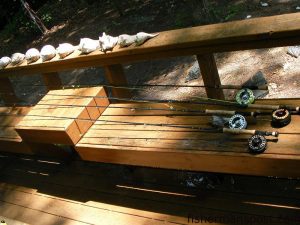Road To Redfish – Fly Rods For Redfish
Welcome to the second installment of the “Road To Redfish” series, wherein Gary Hurley and I are documenting his progression as a novice fly angler into an accomplished fly fisherman. I recently realized that in my introductory article “Path Of The Fly,” which introduces the theme of our entire summer series, that I had not planned to discuss the topic of tackle until a little later. But if someone wished to follow along with Gary and I this summer, the explanation of fly rods, lines, and reels, may help with the choice of outfits to use, borrow, or purchase.
There’s a lot of information to cover, so this article with focus on just fly rod selection.
Gary and I have been throwing 8 weight outfits for all of our casting so far. An 8 weight is arguably the most common fly rod used while targeting redfish, as well as a host of other species. An 8 weight is also probably the best to have rigged and ready in a boat or car should an opportunity arise to cast a fly to a hungry fish, especially here in the Cape Fear region.
The “weight” of a fly rod and its line is referring to the semi-standardized system that designates sizes and suggests its intended use and target quarry. 0 thru 5 weights are appropriate for freshwater trout, while 6 thru 10 weights are designed for larger fish such as redfish, bonefish, permit, and large freshwater species, and 11 thru 16 weights are typically used for tarpon, billfish, tunas, and any other heavyweights.
This is not a steadfast rule, but a broader generalization to be used as a guide and starting point.
Many other factors will contribute to the choice of a certain rod and line combination, such as fly size, expected casting distance, water depth, personal preference, and even wind speed.
While the 7 weight is a good choice for smaller flies and will handle most medium and small reds, and a 9 or 10 weight will throw larger, more wind resistant flies and be able to subdue larger fish, the 8 weight will tackle most redfishing scenarios with ease and is a great starting point.
Now not all 8 weights are the same, and actions differ between manufacturers and even among models of the same manufacturer. Some rods have a slower or more limber action and lend themselves to sinking lines and shorter casts and even “overlining” (using a larger line size than the rod designates).
And stiffer, faster action rods will enable the caster to achieve more distance and accuracy per cast.
The general rule is that slower action rods are better for the beginner because they help you feel the load of the line easier and they are more forgiving when you’re learning to cast.
I like to present different action rods to practicing casters during a single session as this not only helps an angler become familiar with the different types of actions, but it also assists a beginning fly caster in choosing a rod that best fits his or her unique casting style.
I encourage anyone interested to come down to Intracoastal Angler and try out some of our demo rods and reels to get a feel for what type of outfit might be best suited for you. We carry a basic, affordable selection (complete outfits starting at $250) that is geographically and species specific, and we are adding more product weekly.
Thanks for reading, and hope to see you on the water!
Capt. Jon Huff is owner operator of Circle H Charters, an inshore fly and light tackle guide service based out of Wrightsville Beach. Jon splits his time between running inshore charters, fishing offshore tournaments, and co-managing Intracoastal Angler. (910) 617-2619, www.circlehcharters.com






